Ranked Player Survey: The 10 hardest courses in competitive amateur golf
4/5/2023 | by AmateurGolf.com Staff

Our panel of the world's top juniors, ams, mid-ams, and seniors has seen it all; these are the most intimidating courses they play
This is the third in a series of Ranked Player articles, using information gathered by surveys from players listed in our various rankings. So who are these players? Find out here: Ranked Player Survey: top amateur golfers share what they think...and what they know
Our panel of the world's top juniors, amateurs, mid-ams, seniors and super seniors has seen it all. Together, they have competed in thousands and thousands of tournaments in a variety of conditions and courses around the world.
Championship golf is hard enough, but sometimes players run into a golf course that ratchets up the difficulty level beyond anything they are able to adequately prepare for.
We asked our ranked amateur players which was the toughest course they had ever played in competition. We detail the top 10 answers below, with some very particular "honorable mentions".
Q: What is the hardest tournament course you have ever played in competition?
#1: OAKMONT COUNTRY CLUB
Oakmont, Pennsylvania
 Tournaments Hosted: U.S. Amateur, U.S. Open, U.S. Women's Open
Tournaments Hosted: U.S. Amateur, U.S. Open, U.S. Women's Open
If we were to survey top professionals on this question, Oakmont may well top their list too. Every time we see a USGA event (it has hosted the U.S. Open more than any other course), we are reminded why.
The course does not rely on water, OB or trees for its difficulty (a massive renovation in 2007 virtually cleared the property of trees that had been planted decades before). Instead, Oakmont's difficulty comes primarily from (1) the abundance of punishing bunkers and other hazards, and (2) maybe the most terrifying hazard of all: gravity.
At least 175 bunkers dot the property, from deep pots to the sprawling "Church Pews" between the 3rd and 4th holes. Other hazards include a series of narrow trenches that are often marked as penalty areas but are dry and lined with extra-deep grass. The rough itself is thick and lush.
But it is gravity itself that is Oakmont's biggest defense. The fairways are often canted, making finding the short grass more difficult, and several greens run away from the player. And then there is the speed and contour of the greens themselves. How fast are they? Members will tell you that when the U.S. Open comes to town, the USGA actually slows down the greens from their regular speeds. The combination of hazards, rough and topography makes it exceptionally hard to control where the ball stops, and hole putts once it does.
#2: PINE VALLEY GOLF CLUB
Pine Valley, New Jersey
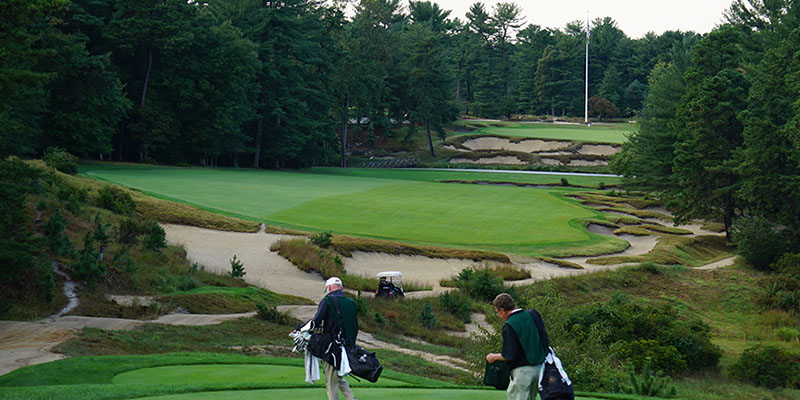 Tournaments Hosted: Crump Cup
Tournaments Hosted: Crump Cup
Most people see Pine Valley ranked #1 on various golf course ranking lists, but those lists give no indication of what makes the course unique and special.
Start with the amazing set of greens. From the long angled tabletop at the 1st to the elevated "ocean waves" green of the 2nd, to the right-to-left banked drop shot green at the 3rd, to the fallaway green at the 4th, to the steeply pitched green at the all-world 5th, and on and on, the greens at Pine Valley are so full of slope and character that there is almost no ordinary hole locations.
Next are the scale and severity of its hazards, most of which are in the form of sand, but which range from tiny little scrapes to sprawling wastelands. Golf writers of the past first told the world about the famous hazards of Pine Valley, from Hell's Half-Acre on the 7th to the Devil's A**hole, the pot bunker on the 10th so deep that many golfers are unable to extract the ball at all. There are no rakes at Pine Valley; the sandy areas and bunkers found throughout the course are true hazards.
Pine Valley is a difficult golf course, and George A. Crump wanted it that way. There was a standing bet that no one could break 80 the first time he played it, and that bet was safe for the vast majority of new players for years. With today's equipment, players have more of a chance than they ever have of going low, and yet every year at the Crump Cup, the best mid-amateur and senior players rarely match or break par in stroke play qualifying.
#3: WINGED FOOT GOLF CLUB (WEST)
Mamaroneck, New York
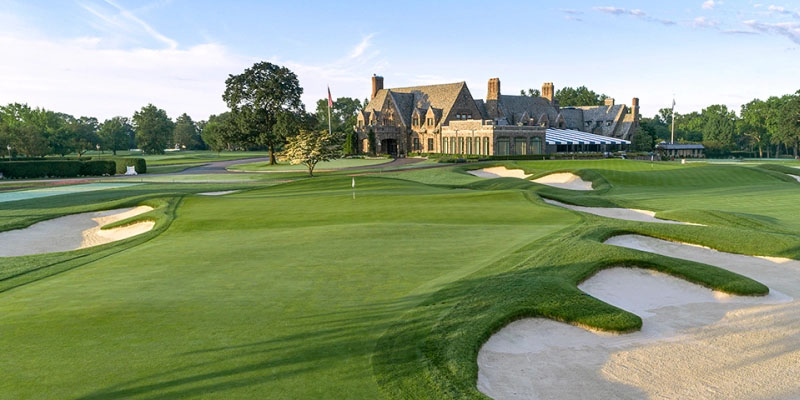 Tournaments Hosted: Anderson Memorial Four-Ball, U.S. Open
Tournaments Hosted: Anderson Memorial Four-Ball, U.S. Open
One could look out over the expanse of holes of the West Course from the clubhouse and wonder what all the fuss is about. The course lacks the stunning visuals of Pine Valley, or the severity of Oakmont. But once on the course, it all becomes evident.
Moreso than any other course other than perhaps Pinehurst No. 2, the genius of Winged Foot is not best understood until within 40 yards of the green. The green complexes are a combination of fast, contoured, often elevated putting surfaces and deep bunkers and green surrounds that make short shots exceptionally difficult to get close to the hole.
What the course lacks in dramatic elevation changes is more than made up for by having ribbon-narrow fairways (kept at or near U.S. Open width throughout the year) and thick rough; even a ball that appears to be sitting up doesn't seem to come out well. It is a relentless test for U.S. Open players, and only slightly less so when playing with a partner at the Anderson Memorial.
#4: CARNOUSTIE GOLF LINKS
Carnoustie, Scotland
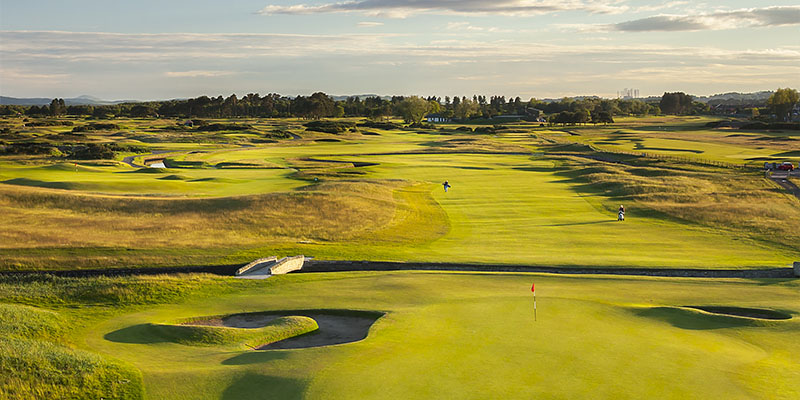 Tournaments Hosted: British Amateur, British Women's Amateur, British Open, Women's British Open, British Boys, British Girls
Tournaments Hosted: British Amateur, British Women's Amateur, British Open, Women's British Open, British Boys, British Girls
The course known to some as "Carnasty" has earned its reputation as one of the most difficult courses in the world. Even without the wind and weather that can roll into western Scotland, this course defends itself with its combination of deep pot bunkers, water (the Barry Burn) and OB. The result is more scorecard-wrecking holes than any other course in the Open rota.
A classic example is the finishing hole, a long par-4 with a tee shot between water right and OB left, an approach over Barry Burn, and a green with OB threatening any shot missed left.
Other beauties are the par-5 6th with "Hogan's Alley", a narrow strip of fairway between pots and OB, providing the ideal line off the tee, and the 250-yard par-3 16th to an elevated green with steep falloffs.
#5: PINEHURST NO. 2
Pinehurst, North Carolina
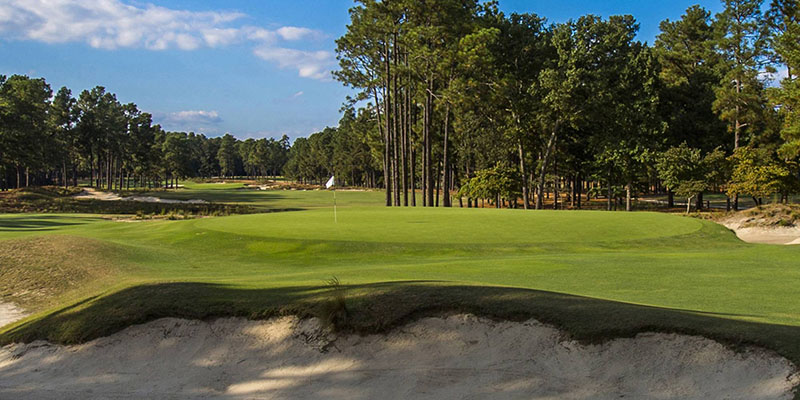 Tournaments Hosted: U.S. Amateur, U.S. Open, U.S. Women's Open, North & South Amateur, North & South Women's Amateur, North & South Junior, Wake Forest Invitational
Tournaments Hosted: U.S. Amateur, U.S. Open, U.S. Women's Open, North & South Amateur, North & South Women's Amateur, North & South Junior, Wake Forest Invitational
Speaking of gravity being golf's most fearsome hazard, nowhere is this more true than at Pinehurst No. 2. The reason is the design of the greens -- they are essentially a set of upside-down bowls, where the pinnable area of each green is far smaller than the green itself. It is not enough to land the ball on the putting surface; a shot landing in the wrong area will inevitably trickle off the green and into the tight-cut surrounds, from which a running chip or putt must be perfectly judged to avoid seeing the ball roll right back to your feet.
Thus the turtle-backed greens require an extra level of precision on approach shots, where the combination of trajectory and spin must match the landing spot on or around the green to keep the ball on the putting surface.
It is practically impossible to prepare for competition on Pinehurst No. 2 until you're on site; nowhere else can the short shots be replicated.
The challenge filters back to the tee, as often the best angle of approach is uncomfortably close to one of the many bunkers and sandy waste expanses that line both sides of the fairway.
THE HONORS COURSE
Ooltewah, Tennessee
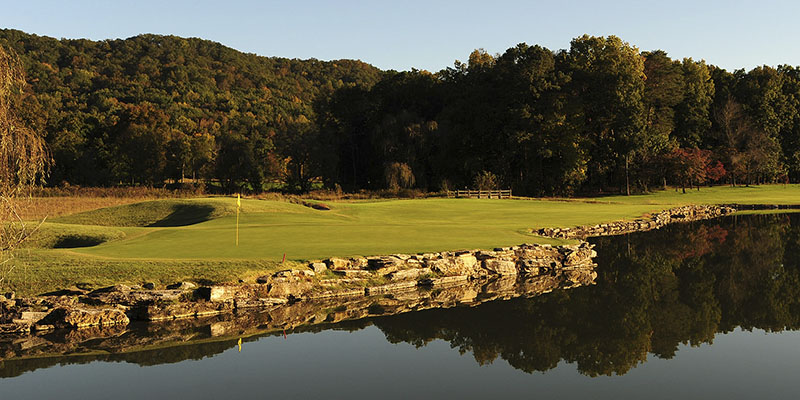 Tournaments Hosted: Lupton Memorial, U.S. Amateur, U.S. Women's Amateur, U.S. Mid-Amateur, Southern Amateur, Tennessee Amateur
Tournaments Hosted: Lupton Memorial, U.S. Amateur, U.S. Women's Amateur, U.S. Mid-Amateur, Southern Amateur, Tennessee Amateur
OCEAN FOREST GOLF CLUB
Sea Island, Georgia
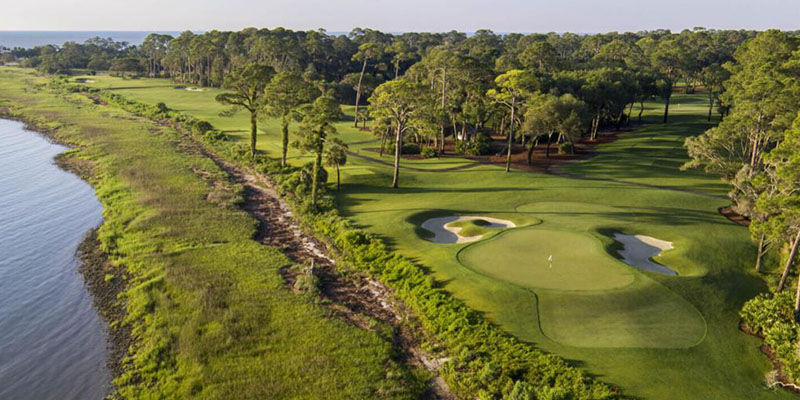 Tournaments Hosted: Jones Cup Invitational
Tournaments Hosted: Jones Cup Invitational
SEMINOLE GOLF CLUB
Juno Beach, Florida
 Tournaments Hosted: Walker Cup, George L. Coleman Invitational
Tournaments Hosted: Walker Cup, George L. Coleman Invitational
PASATIEMPO GOLF CLUB
Santa Cruz, California
 Tournaments Hosted: Western Intercollegiate, California Senior Amateur, SOS Founders Cup
Tournaments Hosted: Western Intercollegiate, California Senior Amateur, SOS Founders Cup
TAMPA PALMS GOLF & COUNTRY CLUB
Tampa, Florida
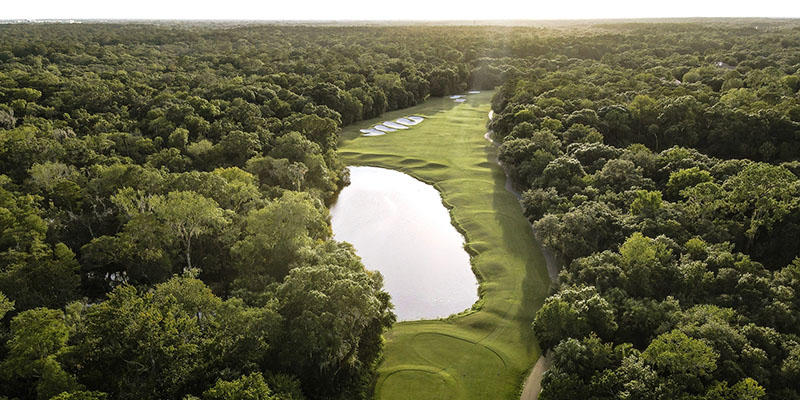 Tournaments Hosted: Golfweek Senior Player of the Year Classic
Tournaments Hosted: Golfweek Senior Player of the Year Classic
Honorable Mention
"There used to be a senior tournament at Old Corkscrew in the Fort Myers, Florida area that was insanely hard! It would include many of the top senior amateurs in the country, and it would take about 10 over to win." - Allen Peake, Macon, Ga.; current #6 ranked senior.
"I’ve played a lot of difficult courses, and it’s tough to pick just one. I think one course can play more difficult than another one day and that difficulty level could switch the next day. For example… Chambers Bay plays very difficult with wind out of the west, but much easier with wind out of the east. OSU Scarlet plays extremely difficult if the rough is up, and not nearly as difficult if the rough is cut." - Mia Hammond, New Albany, Ohio; +6 handicap at age 15
"Merion Golf Club used to have a mid-am event and one year they used it as a test case to show the USGA that the course was tough enough to get back into the U.S. Open rotation. So they made it so hard that the winner (a USGA champion) was 17 over par for the 3 rounds." - anonymous mid-amateur
Be sure to revisit AmateurGolf.com as we continue our Ranked Player Survey series, sharing the expertise and experience of our group of ranked player survey respondents.
Our panel of the world's top juniors, amateurs, mid-ams, seniors and super seniors has seen it all. Together, they have competed in thousands and thousands of tournaments in a variety of conditions and courses around the world.
We asked our ranked amateur players which was the toughest course they had ever played in competition. We detail the top 10 answers below, with some very particular "honorable mentions".
Q: What is the hardest tournament course you have ever played in competition?
#1: OAKMONT COUNTRY CLUB
Oakmont, Pennsylvania

If we were to survey top professionals on this question, Oakmont may well top their list too. Every time we see a USGA event (it has hosted the U.S. Open more than any other course), we are reminded why.
The course does not rely on water, OB or trees for its difficulty (a massive renovation in 2007 virtually cleared the property of trees that had been planted decades before). Instead, Oakmont's difficulty comes primarily from (1) the abundance of punishing bunkers and other hazards, and (2) maybe the most terrifying hazard of all: gravity.
At least 175 bunkers dot the property, from deep pots to the sprawling "Church Pews" between the 3rd and 4th holes. Other hazards include a series of narrow trenches that are often marked as penalty areas but are dry and lined with extra-deep grass. The rough itself is thick and lush.
But it is gravity itself that is Oakmont's biggest defense. The fairways are often canted, making finding the short grass more difficult, and several greens run away from the player. And then there is the speed and contour of the greens themselves. How fast are they? Members will tell you that when the U.S. Open comes to town, the USGA actually slows down the greens from their regular speeds. The combination of hazards, rough and topography makes it exceptionally hard to control where the ball stops, and hole putts once it does.
#2: PINE VALLEY GOLF CLUB
Pine Valley, New Jersey

Most people see Pine Valley ranked #1 on various golf course ranking lists, but those lists give no indication of what makes the course unique and special.
Start with the amazing set of greens. From the long angled tabletop at the 1st to the elevated "ocean waves" green of the 2nd, to the right-to-left banked drop shot green at the 3rd, to the fallaway green at the 4th, to the steeply pitched green at the all-world 5th, and on and on, the greens at Pine Valley are so full of slope and character that there is almost no ordinary hole locations.
Next are the scale and severity of its hazards, most of which are in the form of sand, but which range from tiny little scrapes to sprawling wastelands. Golf writers of the past first told the world about the famous hazards of Pine Valley, from Hell's Half-Acre on the 7th to the Devil's A**hole, the pot bunker on the 10th so deep that many golfers are unable to extract the ball at all. There are no rakes at Pine Valley; the sandy areas and bunkers found throughout the course are true hazards.
Pine Valley is a difficult golf course, and George A. Crump wanted it that way. There was a standing bet that no one could break 80 the first time he played it, and that bet was safe for the vast majority of new players for years. With today's equipment, players have more of a chance than they ever have of going low, and yet every year at the Crump Cup, the best mid-amateur and senior players rarely match or break par in stroke play qualifying.
#3: WINGED FOOT GOLF CLUB (WEST)
Mamaroneck, New York

One could look out over the expanse of holes of the West Course from the clubhouse and wonder what all the fuss is about. The course lacks the stunning visuals of Pine Valley, or the severity of Oakmont. But once on the course, it all becomes evident.
Moreso than any other course other than perhaps Pinehurst No. 2, the genius of Winged Foot is not best understood until within 40 yards of the green. The green complexes are a combination of fast, contoured, often elevated putting surfaces and deep bunkers and green surrounds that make short shots exceptionally difficult to get close to the hole.
What the course lacks in dramatic elevation changes is more than made up for by having ribbon-narrow fairways (kept at or near U.S. Open width throughout the year) and thick rough; even a ball that appears to be sitting up doesn't seem to come out well. It is a relentless test for U.S. Open players, and only slightly less so when playing with a partner at the Anderson Memorial.
#4: CARNOUSTIE GOLF LINKS
Carnoustie, Scotland

The course known to some as "Carnasty" has earned its reputation as one of the most difficult courses in the world. Even without the wind and weather that can roll into western Scotland, this course defends itself with its combination of deep pot bunkers, water (the Barry Burn) and OB. The result is more scorecard-wrecking holes than any other course in the Open rota.
A classic example is the finishing hole, a long par-4 with a tee shot between water right and OB left, an approach over Barry Burn, and a green with OB threatening any shot missed left.
Other beauties are the par-5 6th with "Hogan's Alley", a narrow strip of fairway between pots and OB, providing the ideal line off the tee, and the 250-yard par-3 16th to an elevated green with steep falloffs.
#5: PINEHURST NO. 2
Pinehurst, North Carolina

Speaking of gravity being golf's most fearsome hazard, nowhere is this more true than at Pinehurst No. 2. The reason is the design of the greens -- they are essentially a set of upside-down bowls, where the pinnable area of each green is far smaller than the green itself. It is not enough to land the ball on the putting surface; a shot landing in the wrong area will inevitably trickle off the green and into the tight-cut surrounds, from which a running chip or putt must be perfectly judged to avoid seeing the ball roll right back to your feet.
Thus the turtle-backed greens require an extra level of precision on approach shots, where the combination of trajectory and spin must match the landing spot on or around the green to keep the ball on the putting surface.
It is practically impossible to prepare for competition on Pinehurst No. 2 until you're on site; nowhere else can the short shots be replicated.
The challenge filters back to the tee, as often the best angle of approach is uncomfortably close to one of the many bunkers and sandy waste expanses that line both sides of the fairway.
THE NEXT 5
THE HONORS COURSE
Ooltewah, Tennessee

OCEAN FOREST GOLF CLUB
Sea Island, Georgia

SEMINOLE GOLF CLUB
Juno Beach, Florida

PASATIEMPO GOLF CLUB
Santa Cruz, California

TAMPA PALMS GOLF & COUNTRY CLUB
Tampa, Florida

Honorable Mention
"There used to be a senior tournament at Old Corkscrew in the Fort Myers, Florida area that was insanely hard! It would include many of the top senior amateurs in the country, and it would take about 10 over to win." - Allen Peake, Macon, Ga.; current #6 ranked senior.
"I’ve played a lot of difficult courses, and it’s tough to pick just one. I think one course can play more difficult than another one day and that difficulty level could switch the next day. For example… Chambers Bay plays very difficult with wind out of the west, but much easier with wind out of the east. OSU Scarlet plays extremely difficult if the rough is up, and not nearly as difficult if the rough is cut." - Mia Hammond, New Albany, Ohio; +6 handicap at age 15
"Merion Golf Club used to have a mid-am event and one year they used it as a test case to show the USGA that the course was tough enough to get back into the U.S. Open rotation. So they made it so hard that the winner (a USGA champion) was 17 over par for the 3 rounds." - anonymous mid-amateur
Be sure to revisit AmateurGolf.com as we continue our Ranked Player Survey series, sharing the expertise and experience of our group of ranked player survey respondents.
Most Popular Articles

2025 PGA TOUR Q-School Guide: Sites, Scores, and Who Advanced
Dec 5, 2025Second Stage is complete and Final Stage awaits at Sawgrass — follow every Q-School leaderboard and the players still chasing
2025 LPGA TOUR Q-Series: Final Qualifying Stage FINAL SCORING
Dec 8, 2025Helen Briem earns medalist honors, 31 players headed to the LPGA next year
Australian Open at Royal Melbourne: Preview, amateur bios, and how to watch
Nov 30, 2025Rory McIlroy headlines one of the championship's top fields in years - at least four amateurs will have their chance at glory
Luke Ringkamp Cruises to Rolex Tournament of Champions Title at TPC San Antonio
Nov 26, 2025One week after committing to Pepperdine, Luke Ringkamp won the Rolex Tournament of Champions by nine shots.Inside Gil Hanse’s Restoration of Baltusrol’s Upper Course: A Return to Tillinghast’s
Dec 11, 2025Renowned architect Gil Hanse reveals how he brought Baltusrol’s Upper Course back to life by honoring A.W. Tillinghast’s originalLoading latest news...
